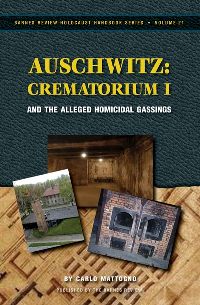In my study Special Treatment in Auschwitz. Origin and Meaning of a Term[1] I have written as follows:
«“Special Units” of the Crematoria
Danuta Czech explains the origin and meaning of the term “Sonderkommando” (special unit) as follows:
“The extermination camp created also one other group of people, those who were forced to work in the crematoria and gas chambers – the unfortunate people were assigned to the work of the special unit. The SS used code words if they spoke about the mass extermination of those ‘unworthy of life.’ It called the mass extermination as well as the transports leading
to selection ‘special treatment’ (often abbreviated as SB). Thus, also, the expression ‘special unit.’”
In other words, since criminal activity described by the code word ‘special treatment’ was allegedly being conducted in the crematoria, the staff employed there had of necessity to be a ‘special unit.’ Naturally it was the only work unit at Auschwitz that merited the prefix ‘special’ [sonder] – otherwise the word would have lost the criminal significance that it possessed according to official historiography.
Based on the documents, the reality is entirely different. First of all, the expression ‘special unit’ does not appear in a single document referring to the crematoria. In its ‘magnum opus’ the Auschwitz museum attempted to prove, on the basis of two documents, that this term was used for the crematoria personnel. The first document is a duty roster for July 18, 1944 [”Dienstplan für Dienstag”, dated 17 July], the second order no. 8/43 of April 20, 1943 from the Commandant’s Headquarters. But the first document merely mentions the term ‘special unit’ in connection with a gate control [Torkontrolle]»
Here a correction is necessary. The mention of the ”Sonderkommando” is not related to the ”Torkontrolle” written on the left (the document is written in two columns) but to four names listed on the right: ”Buch, Kelm, Schultz, Bickel”. Franciszek Piper considers them all to be “members of the SS directly employed in the gas chambers and crematoria”, but this assertion is based solely on the document in question.[2] He also states that Buch, Kelm and Schulz are mentioned as the members of the SS-Sonderkommando of the crematoria by the witnesses Alter Feinsilber (alias Jankowski) and Henryk Tauber,[3] but the first one speaks only of a ”Scharführer Buch” and a ”Kell”,[4] while the other mentions a ”Schultz” and a ”Köln”.[5] One Scharführer Buch, an Unterscharführer Kelm and an Unterscharführer appears (with their proper names) in an undated list of SS-men containing a column of written signatures under the heading ”receipt”, likely related to the payment of salaries. Their tasks are not specified.[6] The Heinz Schulz who according to Piper (whose source refers to a “Schultz”) was a Kommandoführer (commando leader) of the crematoria was identified at the Frankfurt Auschwitz Trial as SS-Unterscharführer Arthur Heinz Schulz, who was the “ Kommandoführer im Arbeitskommando Zerlegbetriebe” (commando leader of the disassembly work commando).[7] Hermann Buch, who according to Piper also served as a Kommandoführer in the crematoria, served, according to the same book in which the Auschwitz historian makes this claim, as Lagerführer of BIIe (head of camp BIIe, the “Gypsy family camp), at the beginning of April 1944. In the eight lines of his biographical note there is no hint that he occupied the – in the context of the ”Holocaust” claims most important – position of a crematoria Kommandoführer.[8]
[Werd: End highlight]
[1] Theses & Dissertations Press, Chicago 2004, p. 101.
[2] F. Piper, «Vernichtung», in: W. Długoborski, F. Piper (eds.), Auschwitz 1940-1945. Studien zur Geschichte des Konzentrations- und Vernichtungslagers Auschwitz, Verlag des Staatliches Museums Auschwitz-Birkenau, Oświęcim 1999, vol. III, p. 261.
[3] Idem, pp. 261-263.
[4] Inmitten des grauenvollen Verbrechens. Handschriften von Mitgliedern des Sonderkommandos, Verlag des Staatlichen Auschwitz-Birkenau Museums, 1996, p. 45.
[5] The Höss Trial, vol. 11, p. 142.
[6] GARF, 7021-108-54, pp. 97 and 98.
[7] Der Auschwitz Prozeß, edited by the Fritz Bauer Institut (Frankfurt am Main) and the Auschwitz-Birkenau State Museum, Digitale Bibliothek, Verlag der Directmedia Publishing GmbH, Berlin 2005, p. 33519, 46036 and 46043.
[8] Aleksander Lasik, «Die Organisationsstruktur des KL Auschwitz», in: W. Długoborski, F. Piper (eds.), Auschwitz 1940-1945. Studien zur Geschichte des Konzentrations- und Vernichtungslagers Auschwitz, op. cit., vol. I, p. 239.








